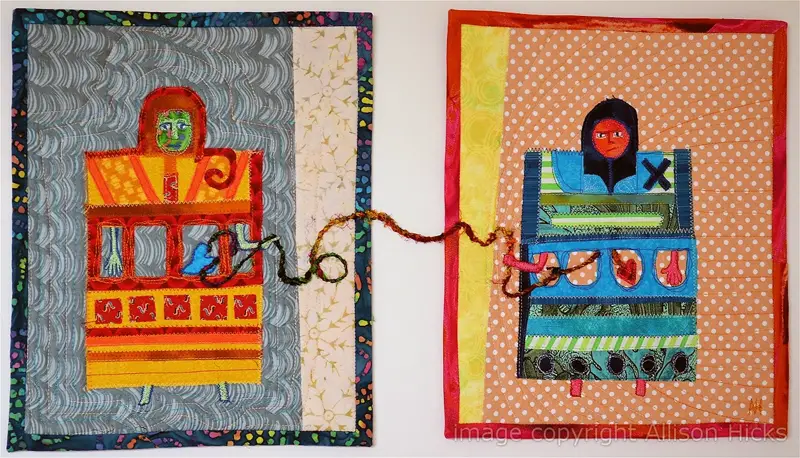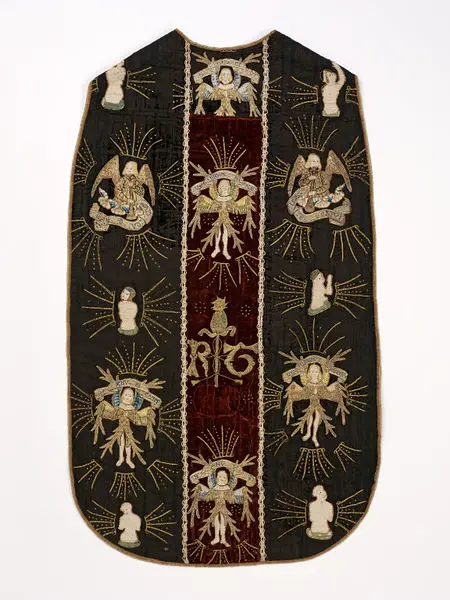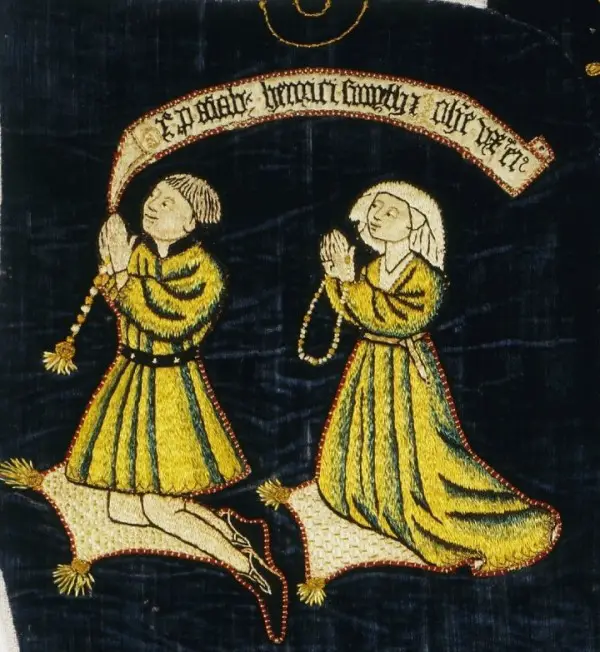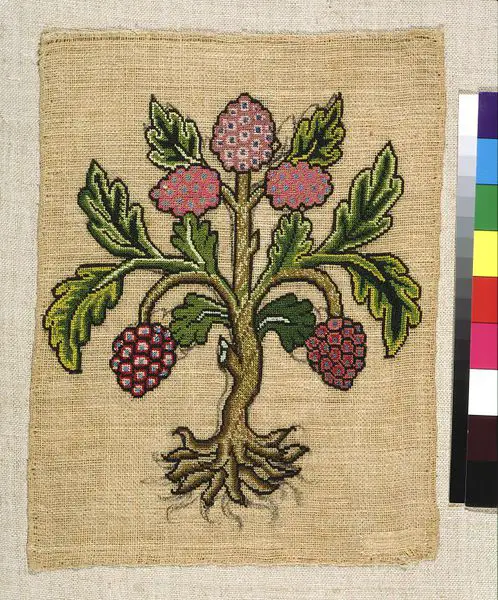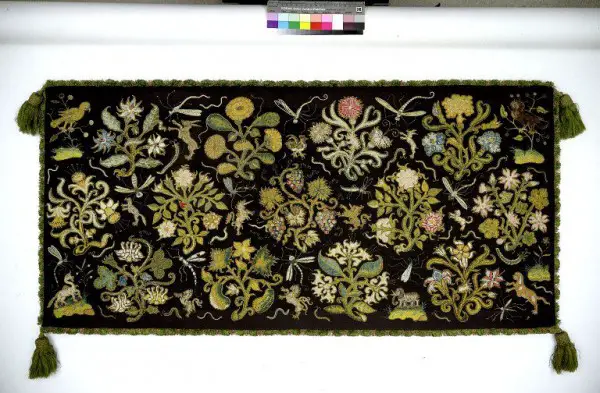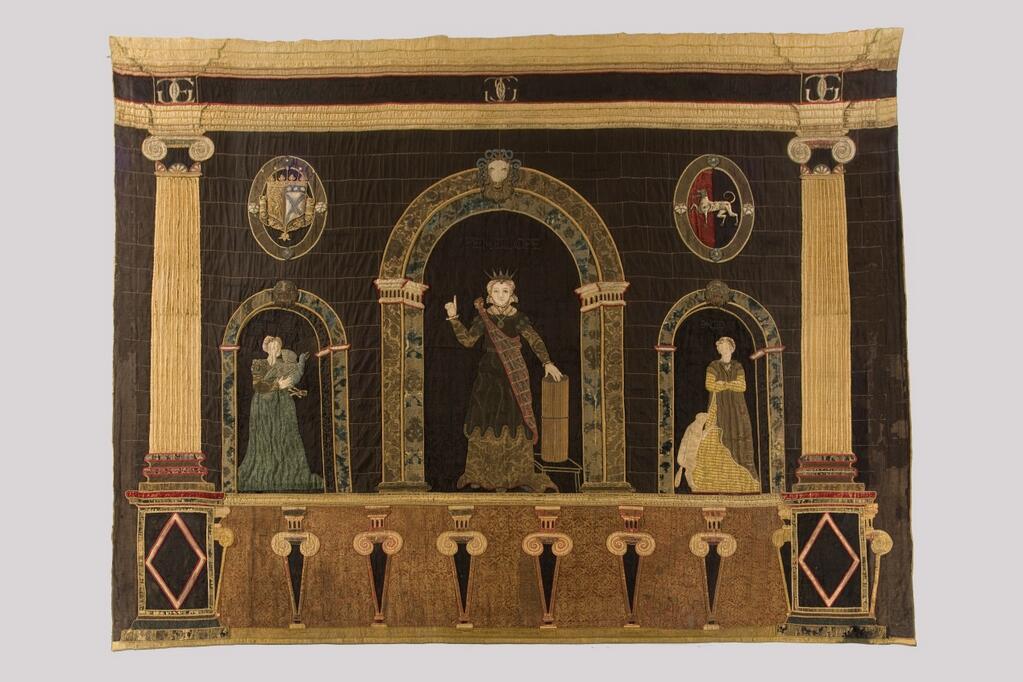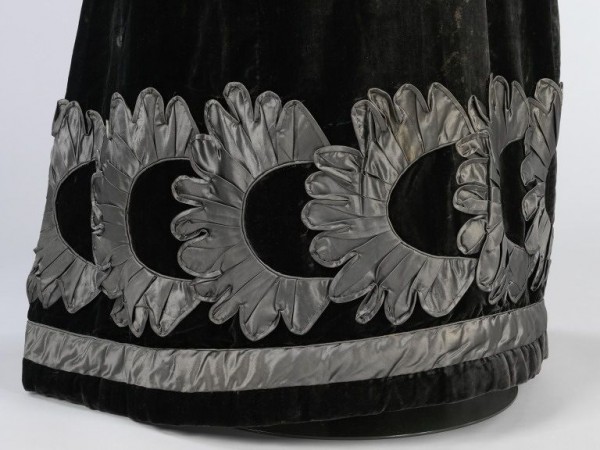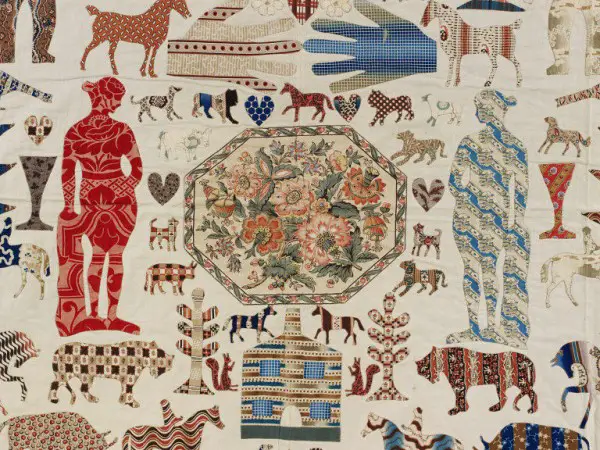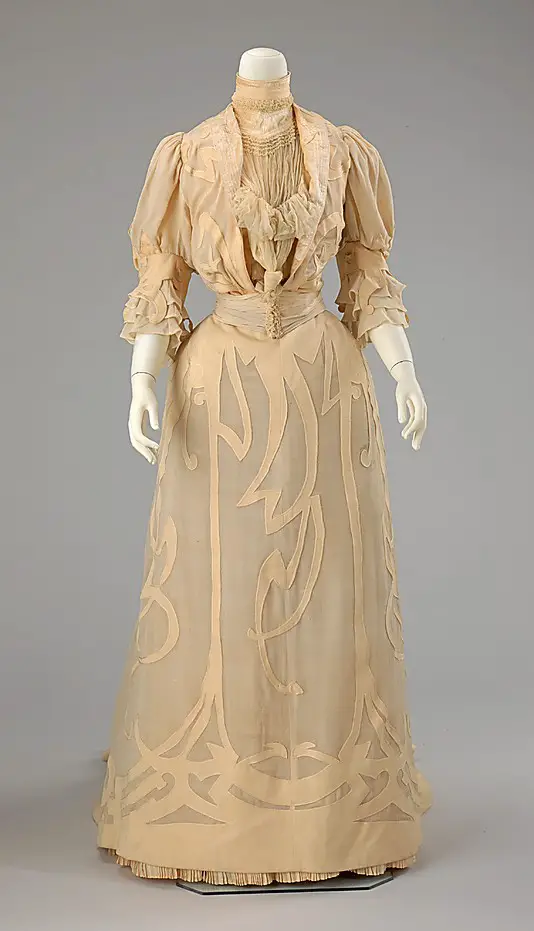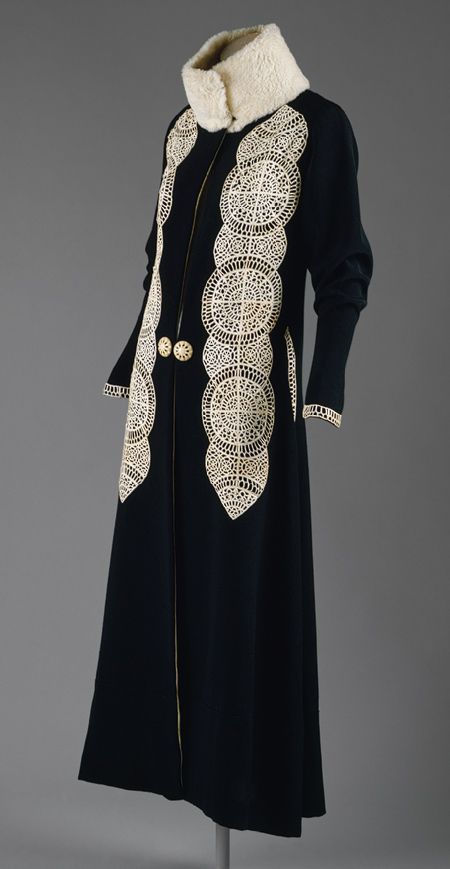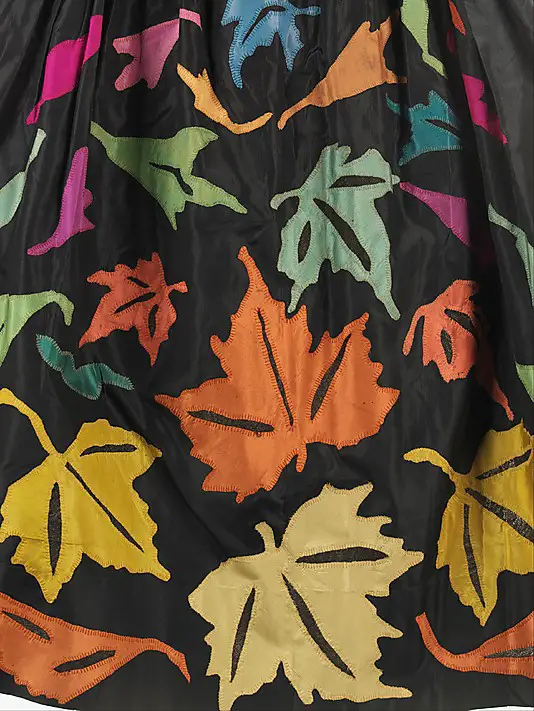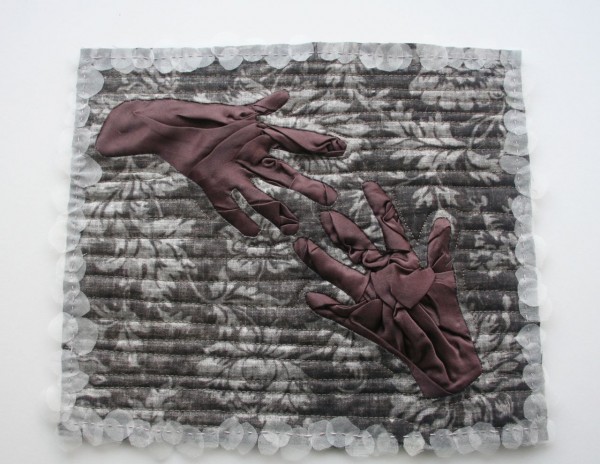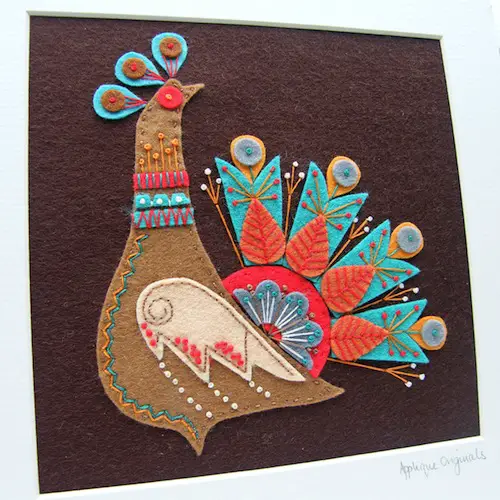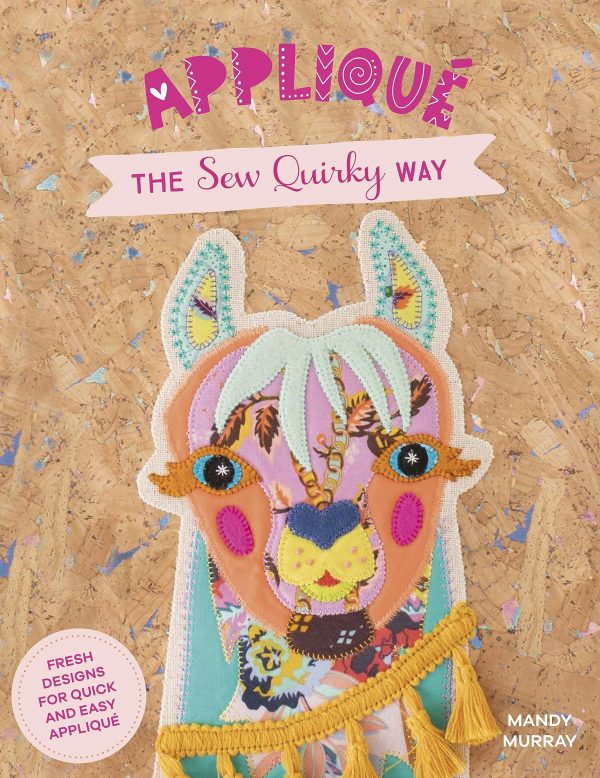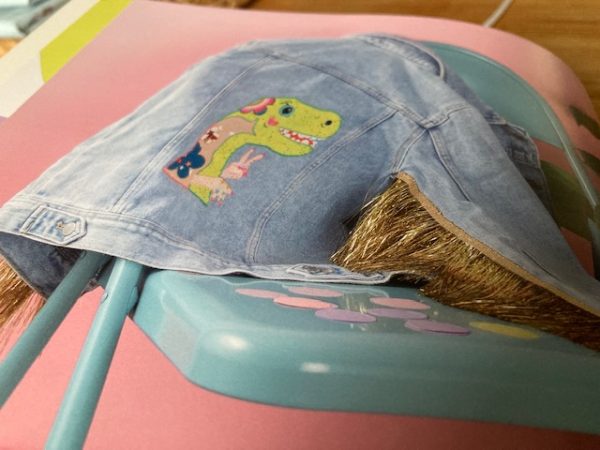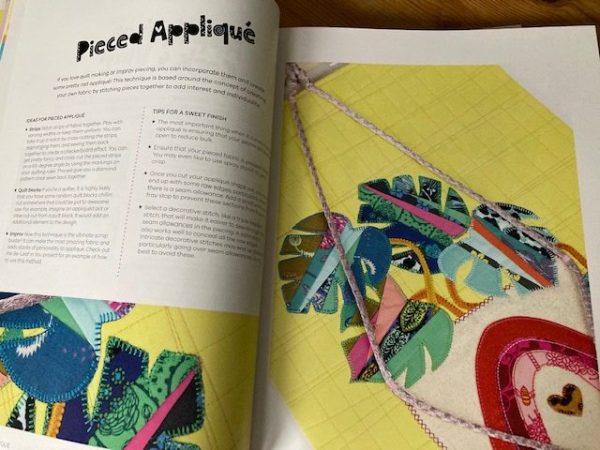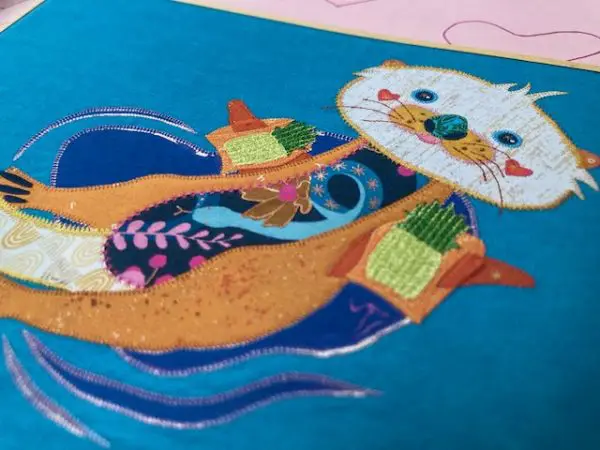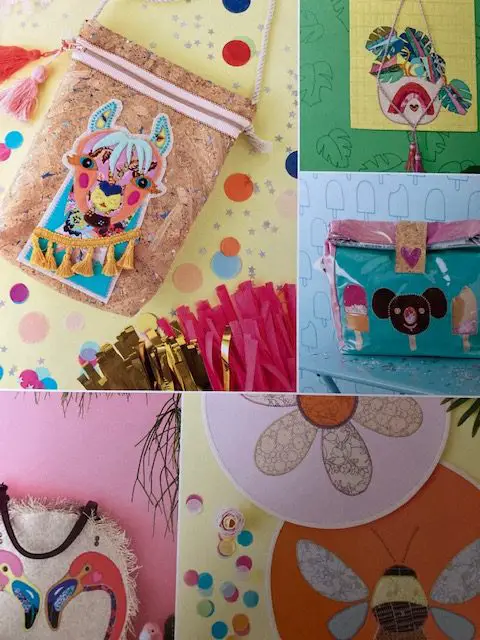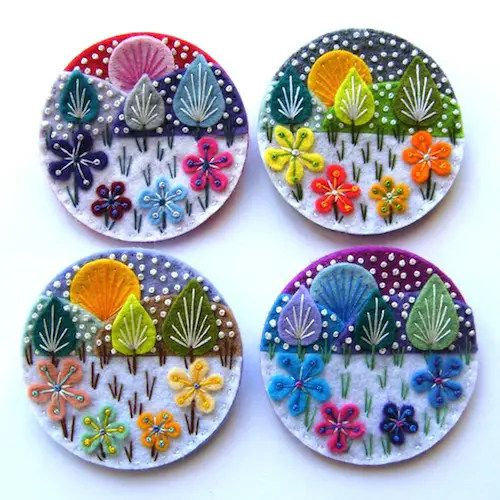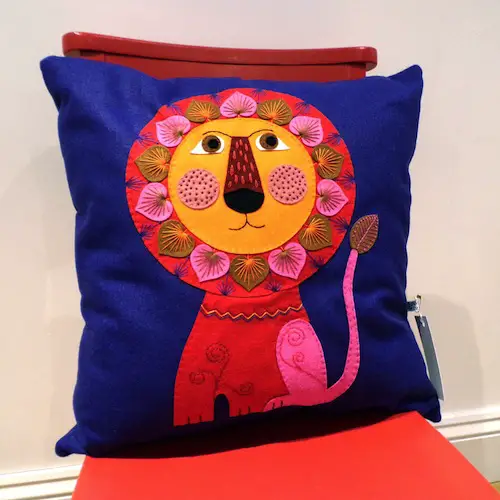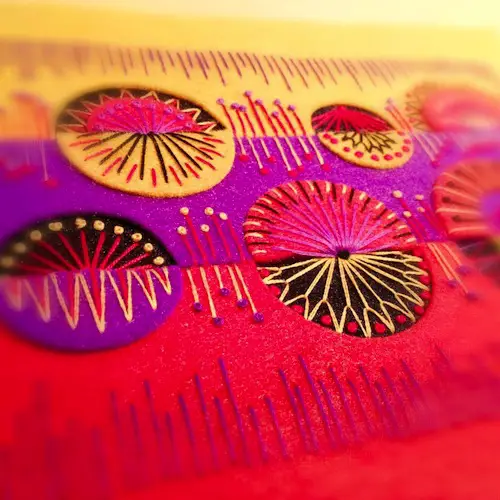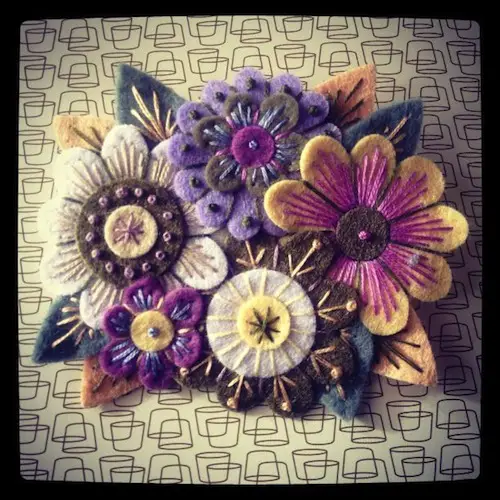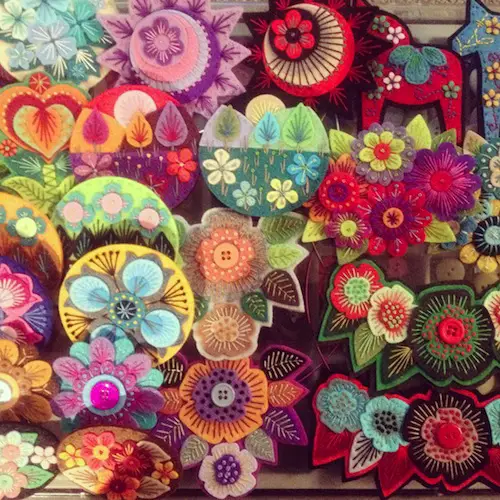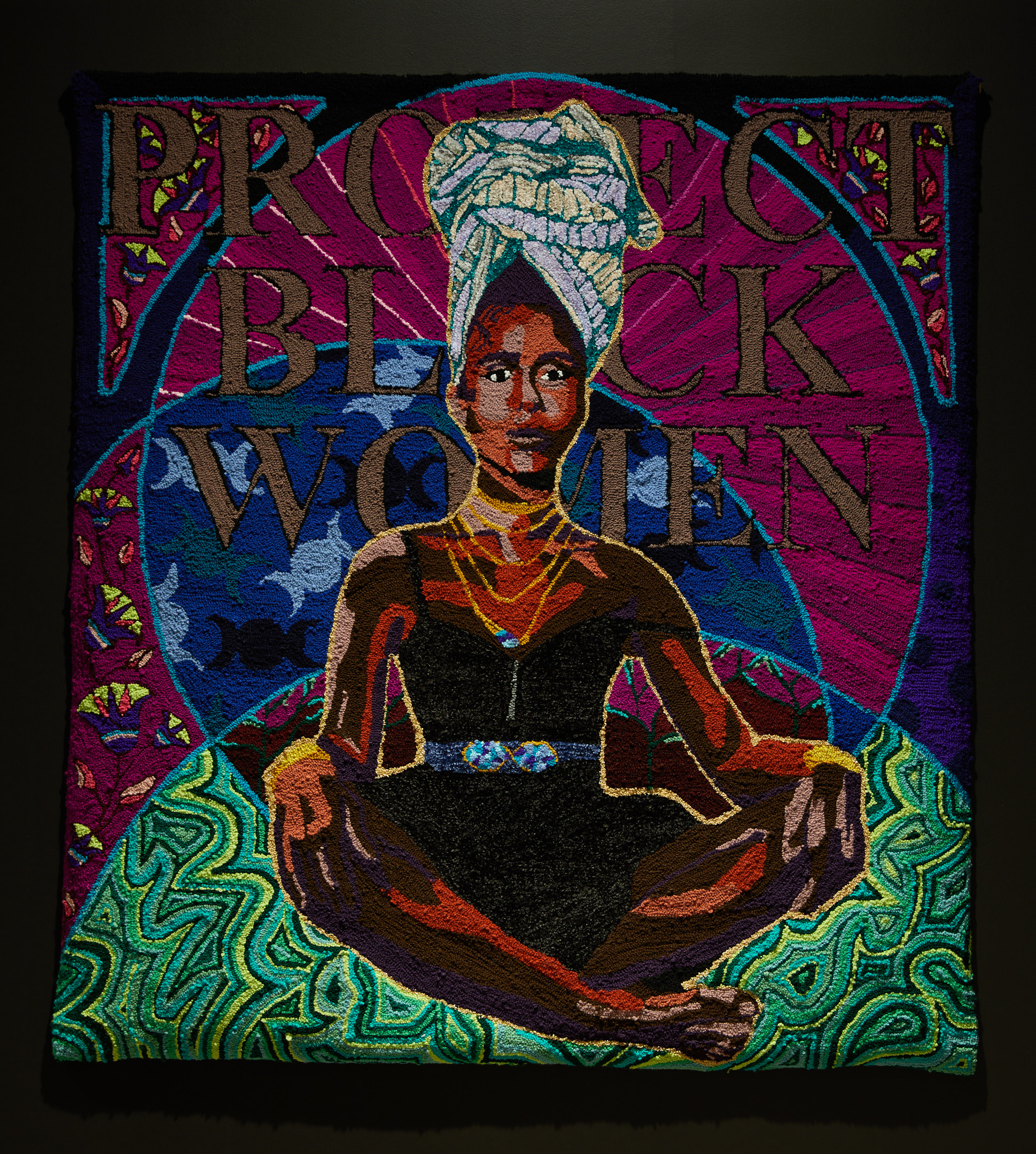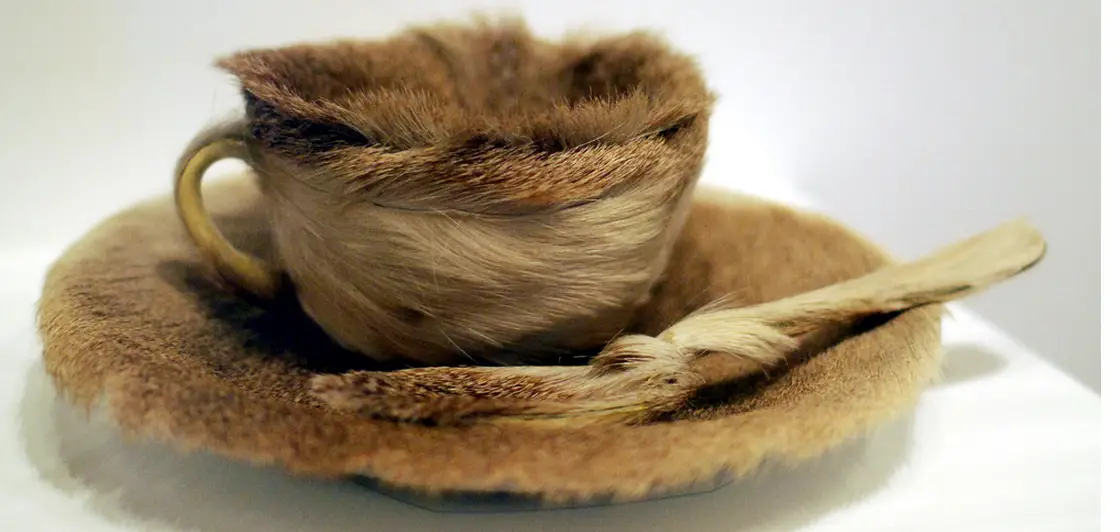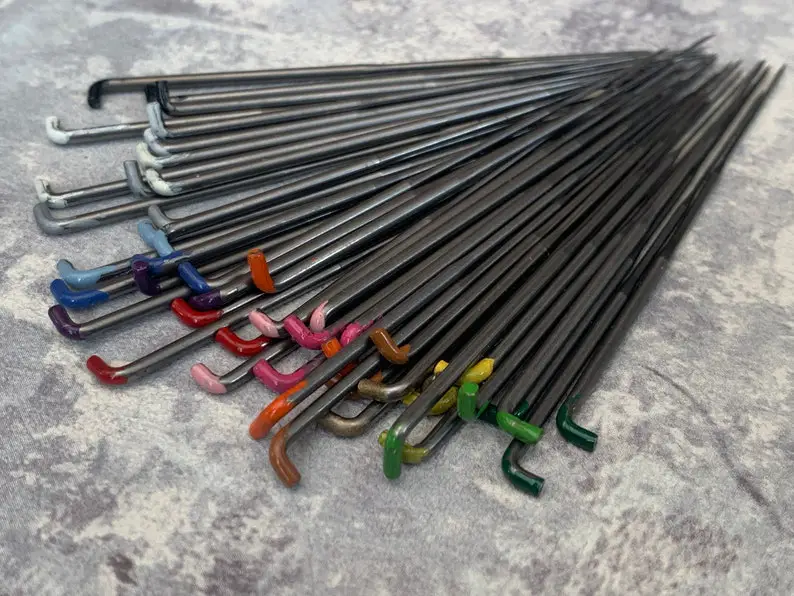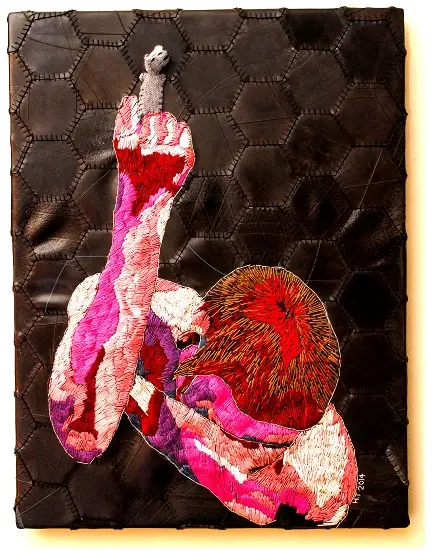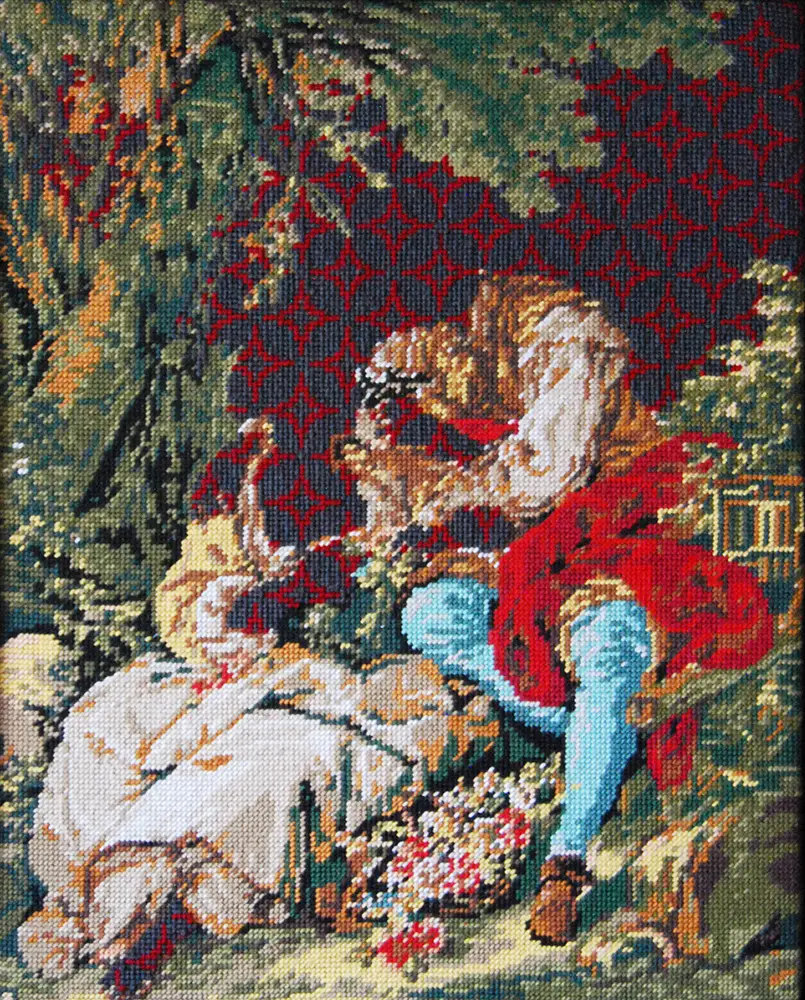If you love fast techniques for creating designs on fabric, appliqué has to be one of the best options. At its most simple, appliqué is the layering of one fabric on top of another to create a design.
In this post you will learn the history of appliqué, explore common appliqué stitches, get book recommendations to help you learn appliqué and be inspired by some amazing appliqué artists.
Table of Contents
Today you can make appliqué ridiculously fast using fusible backing and machine embroidery on top, but for the needlework enthusiast that is missing the slow stitch satisfaction.
Hand-worked appliqué is as meditative as embroidery and the effects can be equally stunning. In times past, appliqué was much faster (and therefore cheaper) than embroidery or weaving so was used to create hangings and decorative textiles to imitate more expensive tapestry.
Appliqué is most commonly used in combination with embroidery or stitching, with the appliqué layers creating a bold decoration and stitch creating the detail.
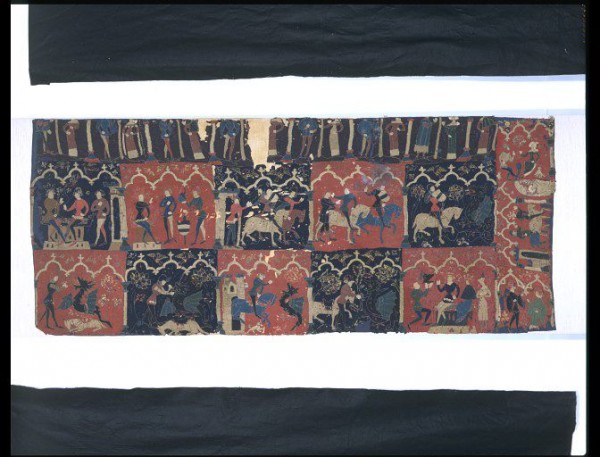
The History of Appliqué
Let’s take a look at some examples of early Western-European appliqué. Your guide on our journey through time is the excellent Ruth Singer.
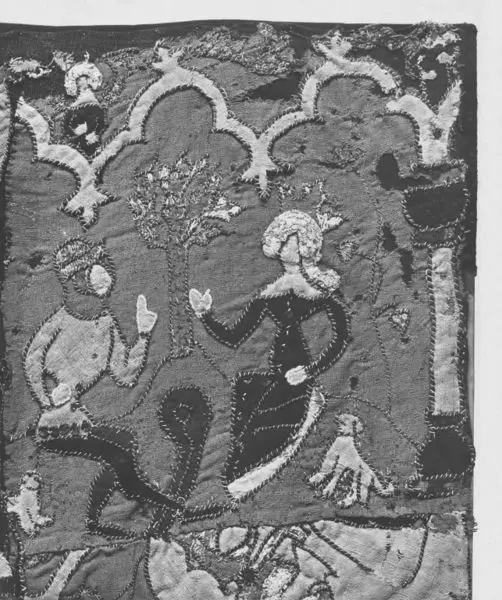
This rare wool appliqué panel depicts the legend of Tristan. The fabrics appear to be the fine, fulled (or felted) wool which was commonly used for clothing, and the motifs are edged with gilded leather.
Later in the 15th century, it became common to embroider motifs onto evenweave linen, then cut the small pieces out and appliqué them onto expensive silks and velvets for altarcloths and church vestments.
Once velvets and decorated silk became available, it was cheaper to produce appliqué than all-over embroidery. This also allowed the lovely velvets and patterned silk damask fabrics to show.
Detail of fragment of altar cloth showing slips applied to velvet background.
The couple shown are the donors, who paid for the altar cloth to be made.
By the 16th century, the technique was used to create bed hangings and cushions. The embroidered motifs were known as slips. Before this time, interior textiles were not heavily-decorated and embroidery was generally reserved for church textiles.
In the 16th century, the fashion for appliquéd decoration really took off and the homes of the wealthy must have been stunning.
Cushion from around 1600, brown velvet decorated with embroidered slips.
Some of the finest early appliqué work is on display at the National Trust house Hardwick Hall; huge narrative panels made by (or under the instruction of) Bess of Hardwick, Countess of Shrewsbury in the 16th century. These huge-scale appliqué hangings are highly unusual, but may well have been more common in their time.
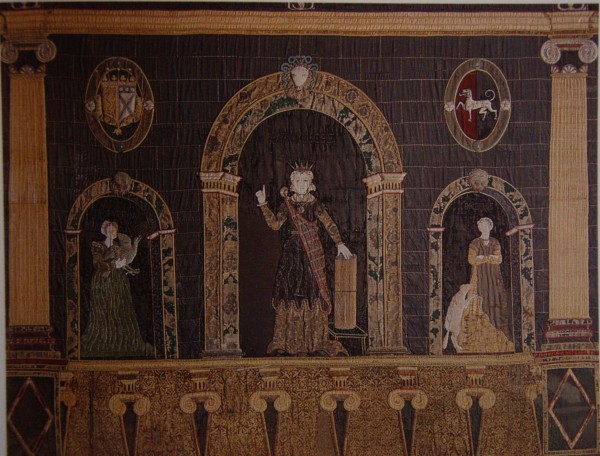
Bess was a collector of fine textiles, including embroidery and decommissioned church vestments, altar cloths and other fabrics deemed unsuitable for the more austere Protestant church, following the Reformation. It appears that she followed a long tradition of recycling of scraps of expensive and luxurious textiles, many vestments were made of vaguely-matching, oddly-shaped pieces put together. She took it a stage further and used large pieces of now-unwanted church textiles to create her own domestic textiles, using these luxurious silks and velvets in ways they had never been used before.
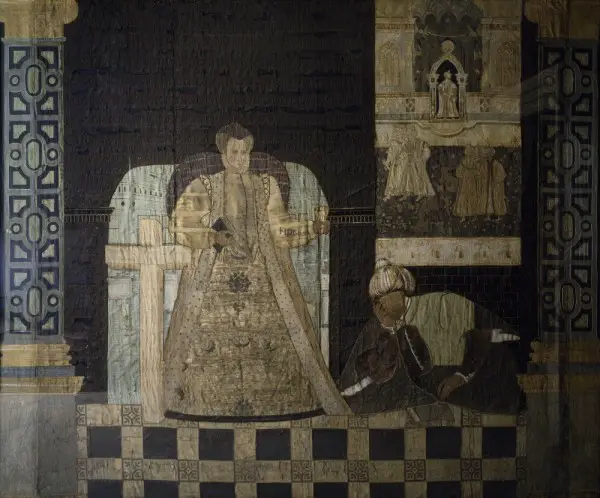
Read more about Hardwick’s collections here, and if you can get hold of it, read this beautiful book about the many textile treasures at Hardwick.
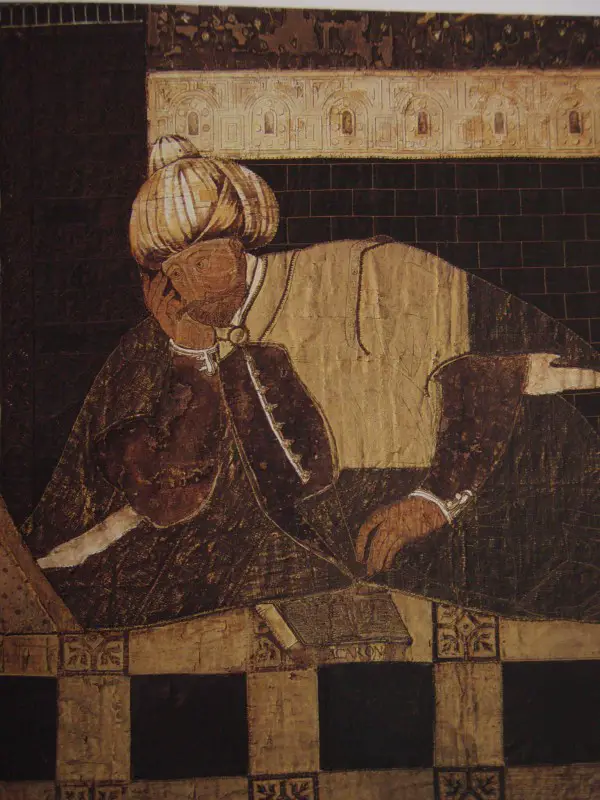
There is a fascinating blog by National Trust textile conservators about these hangings which describes some of the techniques, materials and construction in detail.
We now jump forward a little to 19th and 20th century examples, as well as some contemporary textile artists and designers who use some of the many variations of appliqué.
One of the most exuberant and innovative uses of appliqué are Regency evening dresses. The very luxurious examples, owned and worn by the most wealthy, are decorated with trailing vines, stuffed grapes, raised flowers and an endless variety of decorative detailing.
There seems no end to the creativity of the dressmakers who produced them, perhaps in reaction to the rather simple, minimally-decorated dresses of the earlier 19th century, when white muslin with Indian embroidery was the height of fashion. The styles hark back to the 18th century, when silk gowns were sometimes decorated with applied ruffles, pleats and swirls of self-fabric trim.
As the 19th century wore on, this kind of heavily-textured appliqué fell out of favour for clothing, replaced by pleats, frills, applied braids and fringing. Passementerie really took off and displaced applied fabric as a trimming.
In the world of domestic textiles, gorgeous appliqué quilts, coverlets and panels were made in the 19th century using mass-produced printed cottons, much like those still beloved by quilters and the tradition continued in America, where many beautiful examples of appliqué quilts survive. There’s also a fine tradition of quilts made from appliquéd felt.
Appliqué techniques reappear on garments around 1900 when highly-decorative appliqué is used to create large areas of pattern on garments.
This 1901 Italian wedding dress in the Metropolitan Museum of Art has a skirt decorated with reverse appliqué of wool on silk. The two fabrics as layered together, the design stitched through both and the top layer cut away in parts.
In the teens and 1920s Parisian couturier Paul Poiret excelled in fabulous applied decoration on his ground-breaking designs. This coat using finely-cut leather is one of my favourite pieces ever and inspired my own leather-appliqué coat (though hardly as impressive!).
The 1920s saw another flurry of appliqué in fashion. As well as beading, evening gowns might also be decorated with embroidery or appliqué, often in bold, floral designs and abstract patterns.
Appliqué was often used for the most-expensive lingerie in the 1930s and there is a beautiful nightgown in the V&A collection using shadow appliqué where a coloured fabric is applied on the reverse of a light fabric. These delicate garments were often made by seamstresses working in their own homes, including my own grandmother who made luxury lingerie for Liberty.
Techniques for delicate appliqué were also included in women’s magazines of the period and books were published showing how to create contemporary designs for clothing and home ware, such as my favourite by Kathleen Mann.
The brilliant Elsa Schiaparelli used appliqué on her surrealist-inspired garments. Other couturiers of the 1930s used appliqué extensively including Lanvin for this dress of around 1935.
Meanwhile in the world of textiles, in the 1920s and 1930s, embroiderer Rebecca Crompton brought appliqué to the forefront of art textiles, along with experimental, and still-influential, embroidery techniques.
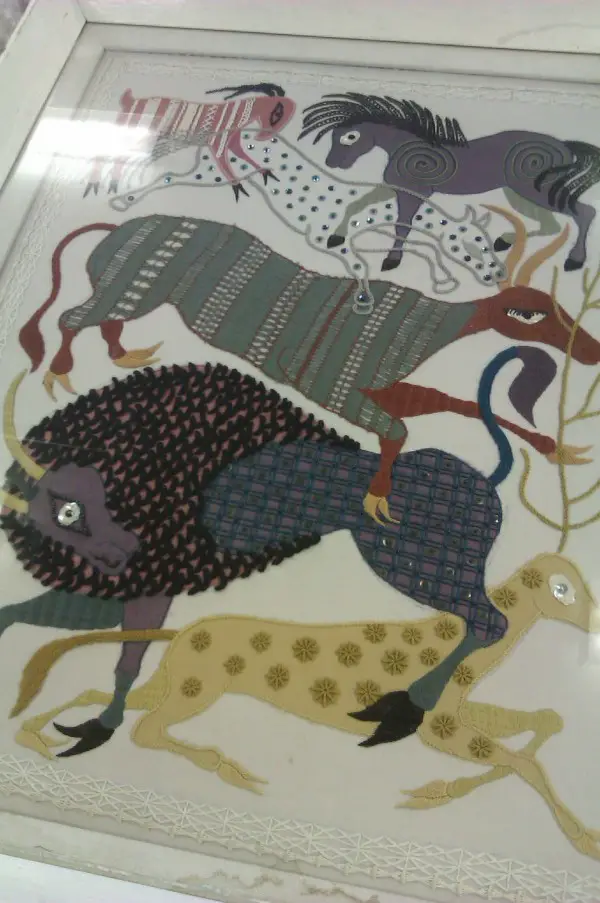

Her style was continued by Constance Howard, another big name in embroidery design and education in the middle of the 20th century.
Couturiers continued to use appliqué techniques to decorate garments throughout the 20th century and the trend shows no sign of disappearing from the catwalks. Cheap production in Asia now allows appliqué to be seen on high street clothing too, as well as cushions and homewares. My Pinterest board on appliqué has some examples of techniques that I find exciting and interesting.
Today, American ethical clothing company Alabama Chanin excel at using appliqué in fashion. Designer Natalie Chanin favours reverse appliqué using simple hand stitch on jersey fabrics to create bold, naturalistic patterns in gorgeous colours.
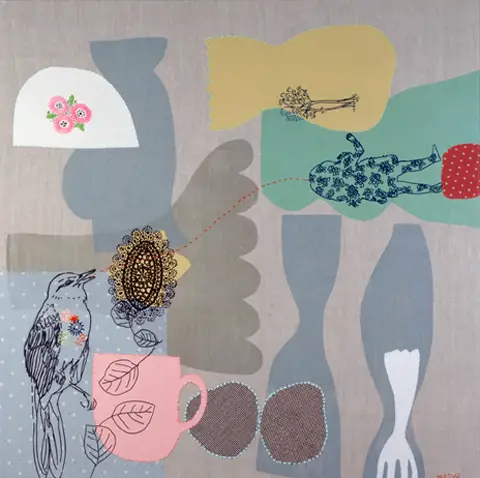
Many textile artists and designers use appliqué in one form another. Maxine Sutton uses bonded appliqué along with screen print and embroidery to create her hand-drawn designs. British designer-maker Alison Willoughby creates stunning 3D appliqué and fabric manipulation techniques, mostly used on her famous skirts.
Artists Jude Hill and Mandy Patullo use layered fabrics as collage, often with vintage textiles, and I use plenty in my own work, ranging from hand-stitched felt in my older work to more delicate reverse appliqué in a recent commission.
What are the different types of Appliqué?
Appliqué means to apply one piece of fabric to another. Usually this is a fabric background with shapes of some sort applied on top. The aesthetic of appliqué is often developed further by using a variety of colours to contrast, for example a red shape placed on a green background. It can then be finished beautifully, special threads to add extra stitching, beading to embellish the shapes, and so on.
Appliqué can be used on many surfaces and can be a decorative way to finish off many objects such as cushions, scarves, bags and clothing. Most surfaces will be able to take appliqué in some form.
Methods of Appliqué
There are three main methods of applying appliqué:
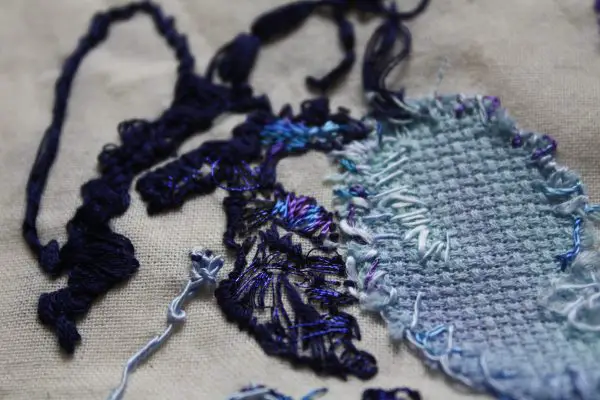
Hand Appliqué
Hand appliqué is when a shape is sewn onto a background layer with a needle and thread and is a popular choice for quilting projects. It can be done in a basic or more decorative way, depending on your experience.
One of the more traditional methods of hand sewn appliqué is the needle-turn method, which is where a needle is used to turn under the seam allowance while you sew the pieces to the fabric background. This creates a neat edge rather than a raw one.
Using hand appliqué allows you to add a decorative finish to your projects and add a variety of patterns and shapes depending on the project being worked on.
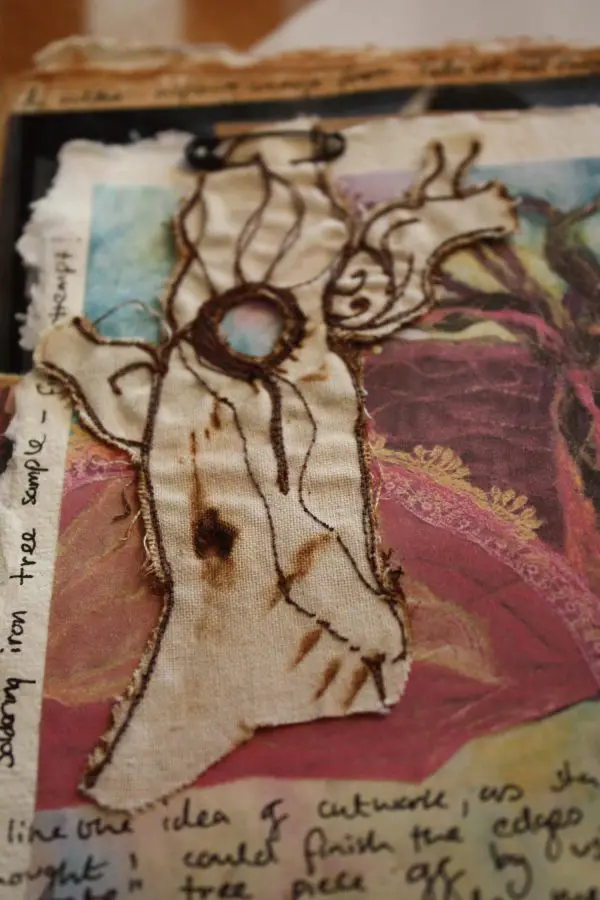
Machine Appliqué
This is when a sewing machine is used to create the appliqué technique for stitching a piece of fabric to a background. You may choose to use one of the stitch variations possible on your particular model of machine to apply your top piece of fabric to the bottom layer. Popular stitches are zigzag stitch or a satin stitch – we will dive into these stitches below.
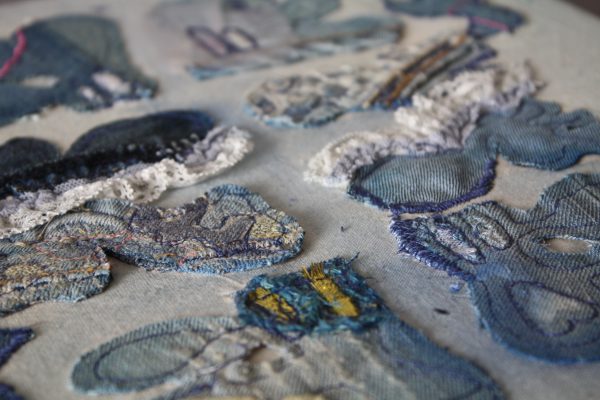
Fused Appliqué
If you are short on time or are less experienced, an iron-on adhesive such as a fusible web can be used. The fabric shapes you create can be fused to the background fabric using this medium and then if desired finishing stitches by hand or machine can be added.
Types of Appliqué
There are the different styles or types of appliqué, some can be done by hand and some on a sewing machine:
- Smooth edge appliqué
- Raw edge appliqué
- Reverse appliqué
- Decorative appliqué
- Multi-needle hoop applique
Smooth Edge Appliqué
Using a sewing machine, the raw edges of the fabric which is being applied to the background can be tidied by stitching around the shape with a stitch chosen to leave a tidy finish which is smooth and neat to the observer. A zigzag stitch stitched closely together works well.
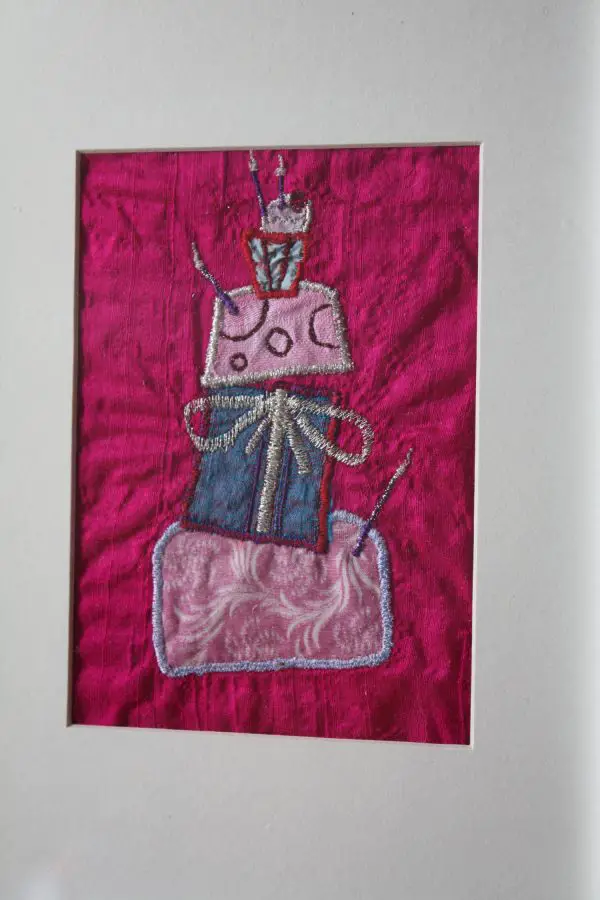
Raw Edge Appliqué
Raw edge appliqué works well for projects which will not be in constant use, as the raw edges are attached to the background fabric but not sewn over to create a seamless edge; the edges are left to fray.
This is ideal for smaller projects, such as greeting cards or wall mounted pieces. Items such as cushions or clothing need to have stronger more durable stitching, so this method is not appropriate in those instances.
Raw edge appliqué can be done by hand or machine, so it is a variable method and can be moulded to the desired project.
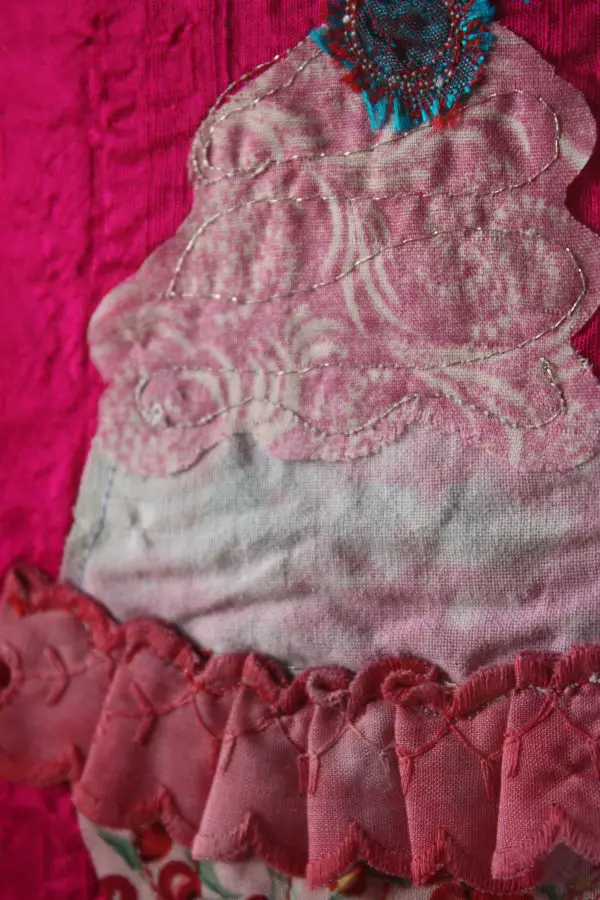
Reverse Appliqué
Instead of sewing fabric shapes onto the top of a background layer, with reverse applique you layer fabrics together and then stitch a pattern on top. Then you cut away parts of the fabric to reveal the shape and colour of the fabric below.
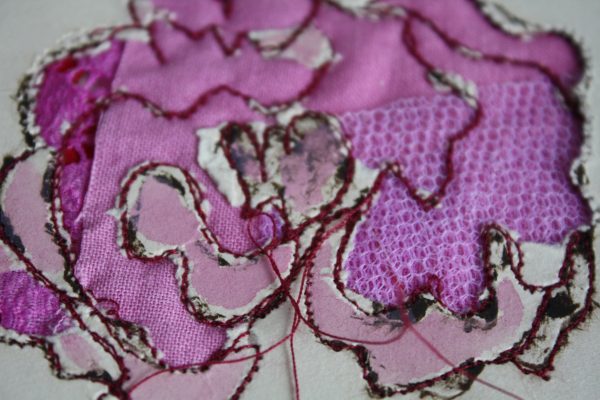
Decorative Appliqué
This method is open to many variations and interpretations. It can be achieved using a machine or by hand.
If you are using a sewing machine, you may use the different styles of stitching available on your model to make your piece aesthetically pleasing.
If using hand embroidery, you can choose to experiment with the many different embroidery stitches available to learn – it depends on the project you are working on.
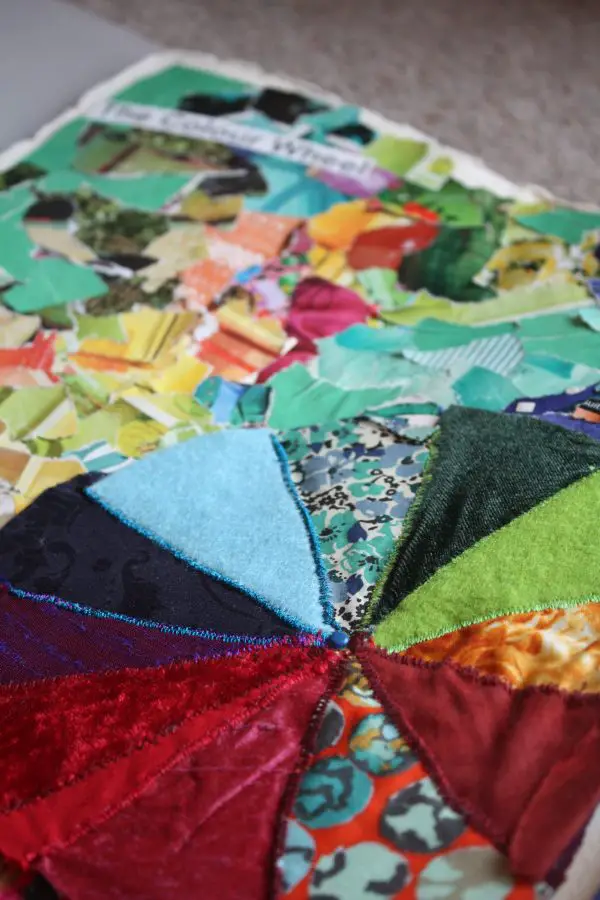
Multi-Needle Hoop Appliqué
This is a machine stitching technique and requires a multi needle sewing machine as well as an embroidery hoop. It is quite a specialised method and not as commonly used, but is of more interest to those who are advanced in their embroidery knowledge.
The machine used can be set up with different colour threads for each needed. Usually there are six needles used in a multi needle machine. Each section of your design will be accurately stitched and it creates beautiful results. It works well for quilting projects.
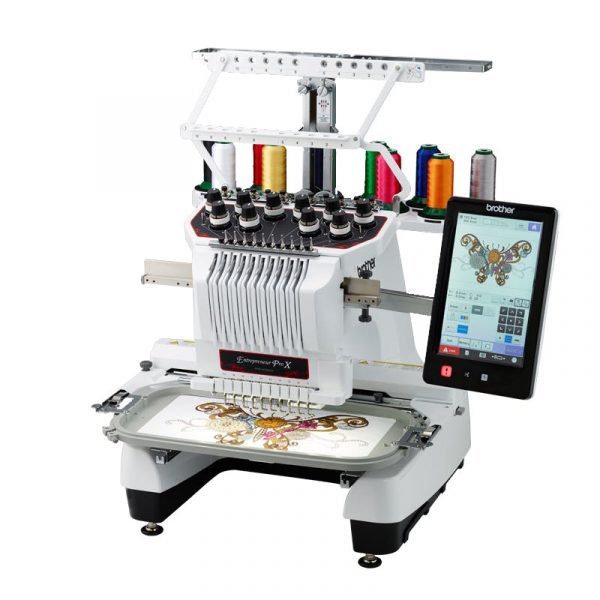
What are Common Applique Stitches?
The two most popular machine appliqué stitches are the Zigzag stitch (also known as the Satin stitch) and the Buttonhole or Blanket stitch.
For hand appliqué, Buttonhole stitch and Appliqué stitch are the most common.
These stitches have specific benefits for reinforcing appliqué work; let’s go into them in a little more detail.
Popular Stitches for Machine Appliqué
Zigzag Stitch
A Zigzag is a more sturdy stitch than the average as it provides more thread contact than a straight stitch would in the same space. It can also be used to prevent fraying, so if you want to have a smoother finish on your appliqué piece then this one will work well.
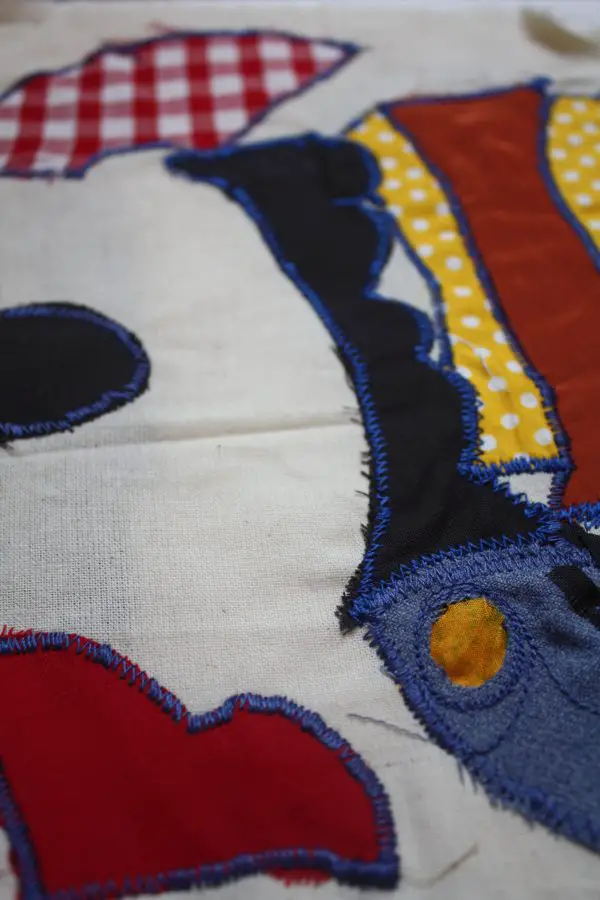
Zigzag stitches can also be decorative, so it not only works practically to hold down your design, it can become a part of the visual appeal as well.
For this piece below, scraps of denim, gingham and other remnants have been used and the contrasting zigzag stitch in blue works well to showcase how the pieces have been appliqued down.

The example above shows a variety of zigzag stitching. This is more decorative, so it shows how many options there are – plenty of choice for you!
Buttonhole Stitch
Buttonhole stitch is a variation of the blanket stitch. It is the stitch used in making buttonholes – no surprise there – but that is not the only use of this versatile stitch. It is often confused with a closely done blanket stitch, but it is different to the trained eye.
Depending on your sewing machine, you may find more than one buttonhole stitch option, possibly up to five! Play with the various stitch width and length settings to find the right look for the piece of fabric you are working with.
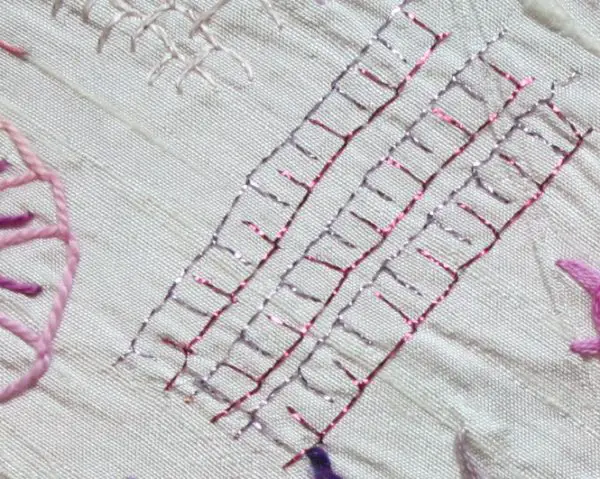
Popular stitches for hand appliqué
Appliqué stitch
The traditionally used applique stitch is worked from under the appliqué pieces. You have to use a single thread on the needle and you do not want the thread to be too conspicuous. The whole point is for the appliqué to stand out with the stitches unseen.
Instead of showing you the “correct” way to do it, I have decided to show you a piece of my own work which it is not meant to look like! The whole idea as I said is to make the work not the stitches stand out, however I decided to go a bit bold here – I chose to make the stitches stand out!
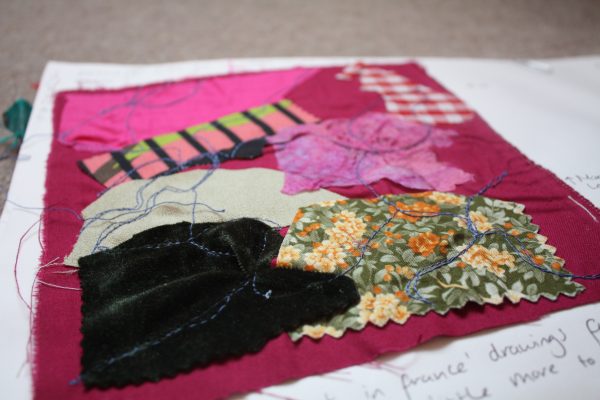
Buttonhole stitch
The hand embroidered version of buttonhole stitch may lack the precision of the machine version but it can be highly decorative and is a popular choice for more rustic pieces. There are many variations, you may choose to use one or a few within your appliqué piece.
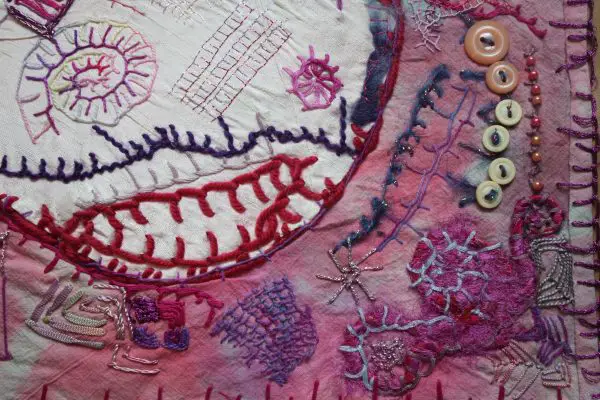
The choice is yours
Appliqué stitches can be both practical and decorative. It doesn’t have to lack your personality and it doesn’t need to be boring. To make it more unusual, you can do the stitches in a different colour to make them stand out, or you can hide them the best you can, using careful neat stitching.
As you can see, it is possible to applique by hand and by machine – this is down to personal choice, there is no right or wrong answer. For some, hand embroidery will be the mindful choice, however the precision of machine applique has great appeal.
What supplies do I need to appliqué?
- Fabric scraps in your chosen colours for your appliqué shapes.
- A base fabric to place your fabric shapes into.
- A template to cut out your shapes.
- A fusible web iron on fabric to place on the bottom of your shapes to stick to the base fabric you are using is an option.
- A pen
- Scissors
- A flat work surface
- Embroidery needle and thread or sewing machine
What Appliqué Books are there?
To get the best from your own appliqué adventure, we’ve reviewed some books for you:
- Appliqué the Sew Quirky Way
Appliqué the Sew Quirky Way
Appliqué the Sew Quirky Way by Mandy Murray is a fun, quirky book with lots of colourful pages exploring the topic of appliqué in an easy to follow way. Mandy Murray is a designer and artist, owning the brand Sew Quirky and with its bright and cheerful edge, this book is great for beginners and those wishing to refresh their skills.
Colour is a massive part of this book and its attraction.
The book is definitely aimed at those who love colour, and it inspires you to pull all the most colourful fabrics you can find to appliqué with joy!
You can mix and match Mandy’s fused raw edge appliqué designs and project instructions to make your own combinations or use any of the appliqué designs to embellish ready-made clothes and accessories, which makes it even more fun to do.
The book documents all the common decorative stitches with instructions on how to accomplish them; this will help the beginner and remind those of you who might be a little rusty.
One great aspect of the book is that there are full-size appliqué patterns included on a pull-out pattern sheet so you don’t need to print them out and stick pages together, and all the appliqué templates are included at full-size so you can get going straight away once you’ve decided which design to tackle first.
There are lovely images to showcase the types of decorative materials you can use and Mandy encourages you to branch out with unusual materials, including, er, cork!
We think this book will bring you joy and at least a smile! It is a great introduction to appliqué with projects that will inspire younger people to try the technique as well.
Applique the Sew Quirky Way: fresh designs for quick and easy applique by Mandy Murray is published by David & Charles. Get your copy here!
Appliqué Artists To Watch
Appliqué is such an accessible technique that we hope you’ll try it. To inspire you, here are some terrific artists using appliqué in their work.
The Colourful Applique Embroidery Of Alli Coate
Alli Coate is an extremely talented artist, working over several different media including illustration, typography and embroidered appliqué.
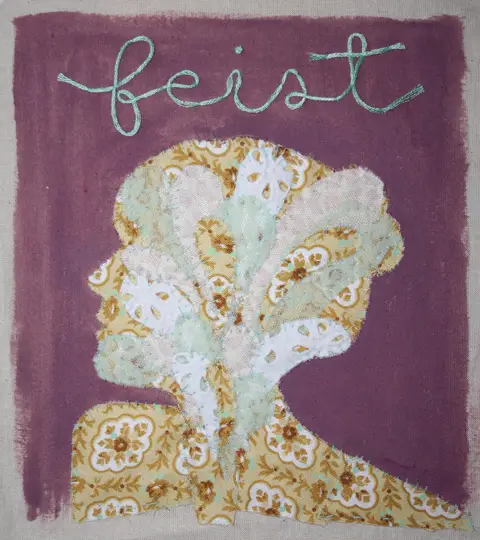
She is adept at painting, drawing and animation, but it is her embroidered works that really get me excited.

She produces wonderful pieces – appliqué work, embroidered text, multi-layered stitchery marvels.
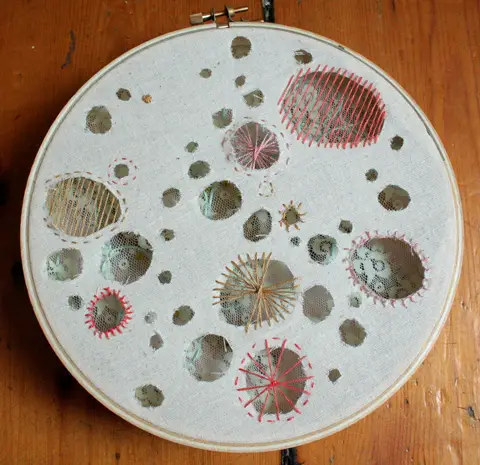
There is a terrific diversity to her work, yet it is underpinned by a quiet charm. Even “Domestic Violence”, twelve embroidery pieces in a refurbished window frame, is softened by the palette of muted tones and quaint fabrics.
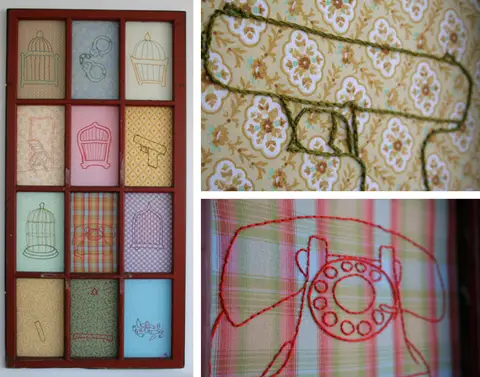
Alli is an obvious talent, and the breadth of her output is admirable. I am always excited to see what she produces next, secure in the knowledge it will stir my soul.
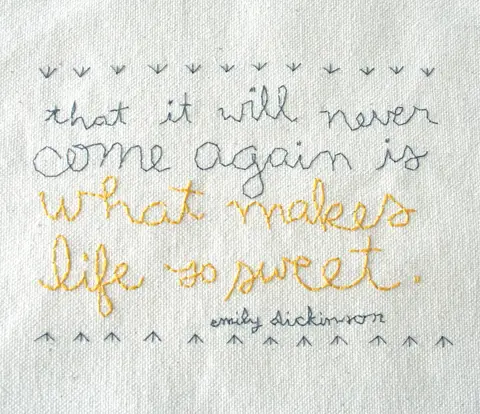
You find out more about her at her website, get to know her better on her blog, and admire her creativity by visiting her Instagram.
Allison Hicks – Appliqué With An Attitude
Allison Hicks, known to fans of Mr X Stitch as Relaxalotl, is a textile artist from Florida, US.
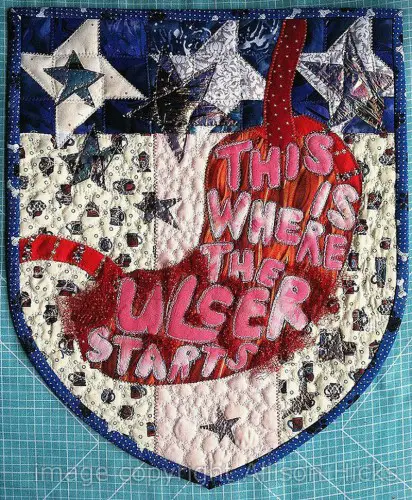
Many of my quilts are inspired by dreams– half-remembered scenes charged with emotion or vivid images that have no place in the waking world. Representational prints layer meaning into an image. Some of my favorite quilts are commissioned pet portraits because they are expressions of pure affection. I highlight the pet’s quirks of personality and appearance, celebrating what makes them unforgettable.
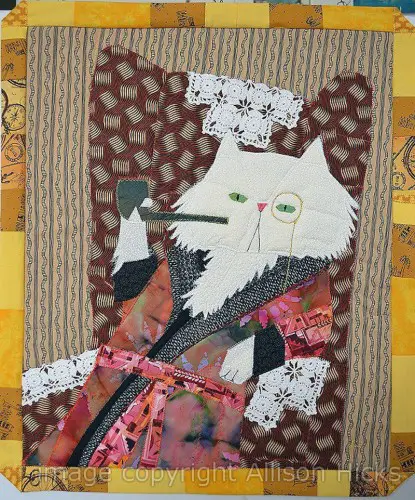
“The process of raw-edge applique forces me to keep my hands and my head working at the same pace, planning ahead and proceeding thoughtfully. I have been sewing seriously for about ten years; my machine is a powerful tool and a safe place for exploration and expression.”
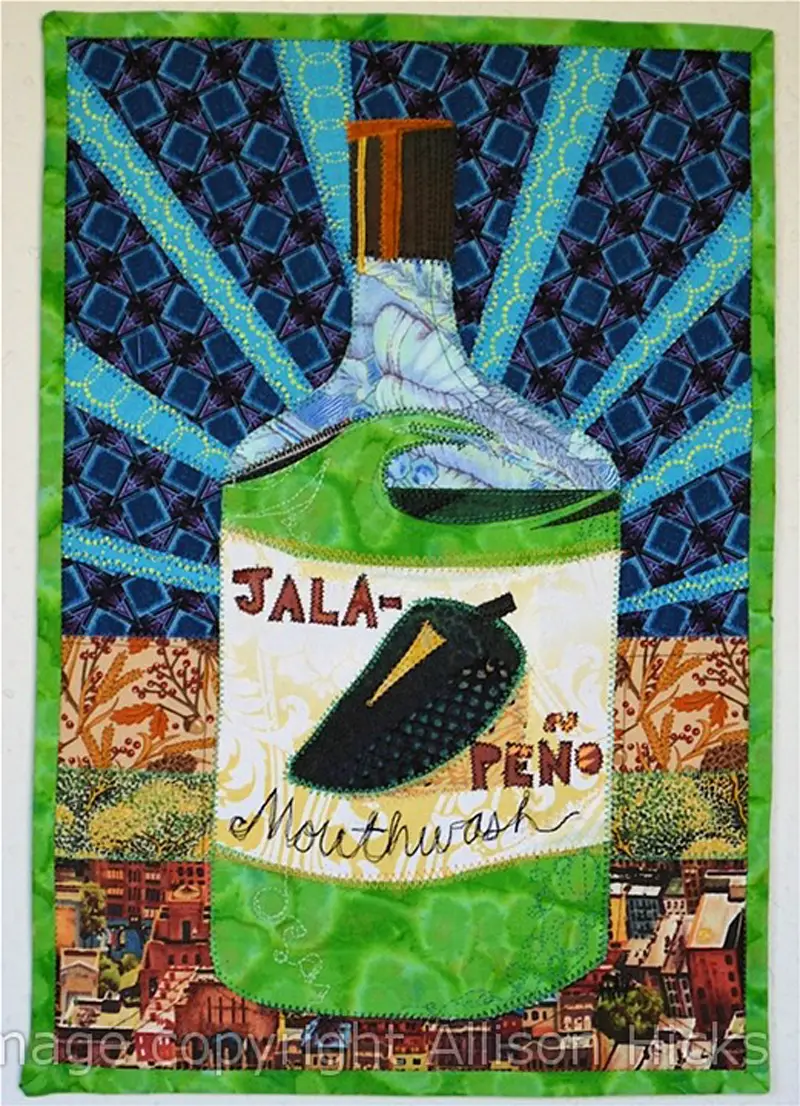
Allison’s quilts are a great example of how much fun quilts can be. Jam-packed with humour and vibrancy, they are cleverly constructed and yet accessible.
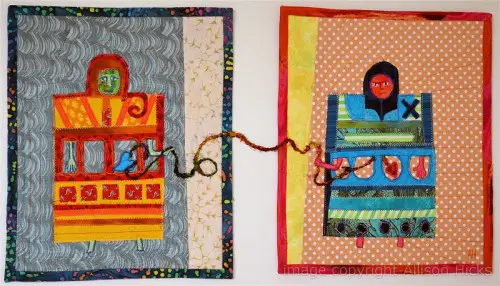
I’m no quilter, but Allison’s pieces make me want to try. They bring a smile to my face and I can only encourage you to visit Allison’s website and enjoy her portfolio of work.
Jane Smallcombe’s Appliqué Originals
Time to celebrate an Etsy seller who uses appliqué with joyful skill as we meet UK-based designer Jane Smallcombe whose Etsy shop ‘Applique Originals‘ is bursting with colourful creations to delight you all.
After a lifetime of making gifts and commissions for friends Jane launched ‘Applique Originals‘ in 2006 with a range of brooches, going from strength to strength ever since. Continuing to flourish, expanding her design range to include stunning collections of jewellery, homewares and children’s toys, lovingly crafted by hand in England, each item is truly a unique work of art.
As well the shop, Applique Originals has also exhibited in galleries and is currently working on a forthcoming joint exhibition with a fellow textile designer.
What is your earliest stitching memory?
Making a felt elephant at junior school with sequin and hand stitched embellishment – I still have it!
What fires your imagination?
I believe inspiration can emerge through a variety of forms. Many of my pieces and colour schemes are derived from nature but I am also a huge fan of pinterest.
I always have a frustrating backlog of ideas that I long to fulfil but in such a busy world it is hard to find the time to initiate new pieces. I am not a planner – I am instinctive. I tend to sit down with a palette of felt and embroidery cottons and begin to cut and sew without a drawing to hand.
I find Jane’s exquisite use of colour utterly captivating, my eyes can’t help but delight in all of her exquisite combinations. The pieces featured in this post barely scratch the surface of all the goodies out there in her shop for all to enjoy, so why not head over there now, fair warning you may get sucked into a time vortex, I’ve found time seems to travel quicker there!

